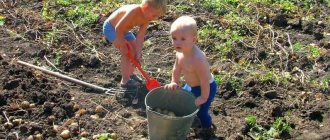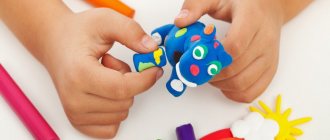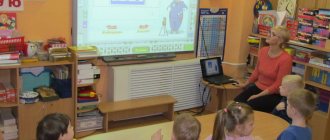The educational and educational process in preschool institutions is undergoing significant changes associated with restructuring in the field of pedagogy and modern trends in the approach to cooperation between adults and children. If earlier this meant a connection based on the “leader and follower” principle, now the joint activity of the teacher with children of different ages comes to the fore.
The concept of activity and its types for preschoolers
Human activity is the basis for the formation and development of personality. It is a special type of activity that promotes interaction with the outside world and helps to creatively transform oneself. Activities can be different - intellectual, creative, physical, and so on. For the successful development of children of different ages, various types of activities are used:
- Children from 1 to 3 years old are suitable for subject-based activities, individual and group games with peers and adults, outdoor games, elements of self-care, listening to fairy tales and music.
- Children from 3 to 7 years old have access to a greater number of types of activities, for example, a variety of games, communicative, research, cognitive and labor activities, self-care, visual and musical creativity, singing, physical activity.
Based on the characteristics of age, it becomes clear that the joint activities of the teacher with pupils in the middle age group of preschoolers are wider and more diverse.
Types of organization of children's activities in preschool educational institutions
There are the following forms of joint activity between the teacher and the children:
- Motor.
- Gaming.
- Fine (including design).
- Perception of folklore and fiction.
- Cognitive and research.
- Communicative.
- Self-care and age-appropriate household chores.
- Musical.
In order to encourage students to be active, competent organization of joint activities between the teacher and children is very important. The teacher must be able to win over group members and interest them without imposing his opinion. Pupils should act freely, without being forced into the play, work or cognitive process. Also important for them is freedom of movement, communication with each other and the teacher, the ability to work at their own pace, without being limited by a specific time period.
The joint educational activity of the teacher with children includes his activity along with his pupils. That is, the teacher should neither impose his attention on the children nor withdraw from influencing the game. If necessary, he can intervene, for example, help resolve a conflict between children, help someone with difficulties, and also contribute to the child’s integration into general activities.
Joint activities of the teacher with children and other preschool employees
Interaction should be present not only in communication between teachers and students, but also in the joint work of all categories of educators. For example, the joint activity of a teacher with a junior teacher provides preschoolers with the best conditions for staying in a kindergarten, since each of the preschool employees not only performs their professional functions, but also joins forces to achieve a joint result.
No less important in the educational process is the joint activity of the junior teacher with children. It contributes to the progress of children in the domestic sphere, self-care, self-knowledge, the formation of sustainable habits and useful skills. At the same time, the nanny works closely with the teacher, supporting him in all contacts with the children.
To achieve significant progress in correctional and developmental work, the joint work of a speech therapist and a teacher is also important. To do this, it is necessary that the specialist’s activities be successfully integrated into the general educational and educational process. At the same time, the age characteristics of individuals in need of correction are taken into account, and the teacher in every possible way supports the work of the speech therapist. In this case, the students treat the specialist much calmer and more loyal, which makes the correction process more productive, faster and more effective. Kids do not focus on shortcomings, but strive to achieve better results.
Working with parents and students
The joint activities of the teacher with children and their parents are equally important. It is impossible to carry out educational work and training only in kindergarten if at home the children do not receive the necessary information in the same way in which the teacher presents it. Parents and teachers of preschool educational institutions must work closely together to obtain an integral result and raise the child to be a full-fledged, developed, socialized and successful creative personality.
In the work of a preschool institution, a variety of topics are used in the joint activities of the teacher and children. They can be dedicated to various types of games, holidays, weather phenomena, puzzles and rebuses, construction, drawing and much more. Each of these projects of joint activity between the teacher and children has its own goal and direction. In order to cover the children’s interests as widely as possible, a cyclogram of the teacher’s joint activities is drawn up. It allows you to plan full-fledged activities for every day of the week, taking into account the age characteristics of children and allows you to harmoniously combine different types of activities. A supporting role is also played by a plan-outline of the joint activities of the teacher and children, thanks to which the teacher can control the correctness of the lesson at all its stages.
Joint activities make it possible to achieve a close partnership between teacher and student through a combination of activity and independent desire to understand the child and unobtrusive and delicate management of his interests on the part of an adult. Moreover, in such work there is no rivalry or oppression of one of the parties. When a child feels support, and not coercion or pressure from the teacher, he can develop more freely, while joining the society of his peers. That is why joint activities have such important goals and a significant role. It is important for all kindergarten students, but is especially in demand for the socialization, education and development of children with an introverted, problematic character, the presence of various characteristics and disorders, shy and timid. Often, in a team with an authoritarian leader and more active, energetic children, such students do not receive the necessary attention, do not join the team, and stay away.
When using the method of joint activity, it is possible to unobtrusively bring such children “out of the shadows”, reveal their potential, and activate their mental and physical capabilities. As a result, all members of the children's team receive the proper degree of attention. Children develop successfully and learn the basics of education and upbringing in an easy, accessible and useful way.
Interaction between adults and children
The interaction of adults with children is the most important factor in the development of a child and permeates all areas of educational activity.
With the help of an adult and through independent activities, the child learns to explore the world around him, play, draw, and communicate with others. The process of familiarization with cultural patterns of human activity (culture of life, knowledge of the world, speech, communication, etc.), acquisition of cultural skills when interacting with adults and in independent activity in a subject environment is called the process of mastering cultural practices.
For personally generative interaction
characterized by acceptance of the child as he is and faith in his abilities. An adult does not adjust the child to a certain “standard”, but builds communication with him focusing on the child’s strengths and individual characteristics, his character, habits, interests, preferences. He empathizes with the child in his joys and sorrows, provides support during difficulties, and participates in his games and activities. An adult tries to avoid prohibitions and punishments. Restrictions and reprimands are used when absolutely necessary, without humiliating the child’s dignity. This style of education provides the child with a sense of psychological security, contributes to the development of his individuality, positive relationships with adults and other children.
Personally generative interaction contributes to
formation of various positive qualities in the child.
The child learns to respect himself and others, since the child’s attitude towards himself and other people always reflects the nature of the attitude of the adults around him. He gains a sense of self-confidence and is not afraid of mistakes .
When adults provide a child with independence, provide support, and instill faith in his strength, he does not give in to difficulties and persistently seeks ways to overcome them.
The child is not afraid to be himself, to be sincere. When adults support the child’s individuality, accept him for who he is, and avoid unjustified restrictions and punishments, the child is not afraid to be himself and admit his mistakes. Mutual trust between adults and children contributes to the child's true acceptance of moral standards.
The child learns to take responsibility for his decisions and actions. After all, the adult, wherever possible, gives the child the right to choose one or another action. Recognition of a child’s right to have his own opinion, to choose activities to his liking, and play partners contributes to the formation of his personal maturity and, as a result, a sense of responsibility for his choice.
The child learns to think independently, since adults do not impose their decisions on him, but encourage him to make his own.
The child learns to adequately express his feelings. By helping the child understand his experiences and express them in words, adults help him develop the ability to express feelings in socially acceptable ways.
A child learns to understand and sympathize with others because he receives this experience from communicating with adults and transfers it to other people.
An educational organization must create conditions that ensure positive, friendly relationships between children, including those belonging to different national, cultural, religious communities and social strata, as well as those who have different (including limited) health capabilities.
The nature of interaction with other children is determined by the age characteristics of children. As studies by M.I. show. Lisina, the child’s need to communicate with children appears in older preschool age. At this time, the preschooler’s system of relationships changes from an extra-situational-cognitive form of communication (3-5 years), when the leader was communication with an adult, the child moves to another extra-situational-personal form. The nature of gaming activity is changing; the role of those who provide the content of the game on an equal basis is important. Children learn to negotiate roles, resolve conflict situations with peers, and work in a peer group.
It is important to understand that the skill of interaction is formed gradually when children of early and early preschool age are combined in round dances, active and role-playing games. Children are taught the ability to communicate with peers when organizing dramatization games, theatrical games, and learn the culture of communication when creating special situations.
Children with visual impairments are characterized by the difficulty of updating communication norms obtained in joint activities, due to a decrease in orienting activity, therefore a variable developmental environment is created in which the child will have the opportunity to master cultural means of interaction; he will be provided with support in organizing gaming activities and joining a group of peers. Full interaction with peers can be ensured through the inclusion of the child in a variety of activities that promote the development of thinking, speech, communication, imagination and children's creativity, personal, physical and artistic-aesthetic development of children.
The child’s system of relationships with the environment is based on ensuring emotional well-being through communication with adults, children, respectful attitude towards each child, his feelings and needs.
It is important to support children’s individuality and initiative through creating conditions for children to freely choose activities, creating conditions for children to make decisions, express their feelings and thoughts; supporting children's initiative and independence in various types of activities (play, research, design, cognitive, etc.).
The formation of a child’s interaction with the outside world, the formation of the “I” concept is carried out in joint activities with adults and children, in directly organized and independent activities. Adults need to create special conditions for this, ensuring that children are included first in display games and then in role-playing games; prepare conditions for cognitive and motor activity of children, for their inclusion in experimentation. It is also important to organize the child’s privacy, giving him the opportunity to be and play alone.
The system of relationships of a visually impaired child to the world, to other people, to himself is formed through instilling in him respect for the rights and responsibilities of another person, love for his homeland, loved ones, education in hard work, a value-based attitude towards his own health and the health of others, towards nature.
Significant in this system of relationships is the formation in the child of independence, self-esteem, and understanding of his individuality.
Considering that children with visual impairments often have low self-esteem, and as a result, the child’s inclusion in various activities suffers, preschool educational institutions should provide support for the child from specialists: a typhoid teacher, a teacher-psychologist.
2.5. Interaction of the teaching staff with families of preschool children
Target
interaction of the teaching staff with the family of a visually impaired pupil - to promote the formation by parents (legal representatives) of the child of an adequate attitude towards his present and future capabilities and needs with an increase in the role of the family in the physical development and socialization of a preschooler with visual impairment.
It is known that parent-child relationships in families of visually impaired children are determined by the attitude of parents (legal representatives) to the child’s visual impairment. Parents (legal representatives) can take different positions:
- accept the child as he is;
— accept the fact of visual deprivation as a harsh reality;
— ignore (not accept) the fact of visual deprivation.
The inadequate position of parents towards the capabilities and needs of a visually impaired child is manifested in styles of family education that are unfavorable for his personal growth - overprotection or hypoprotection, which act as a brake on his development.
The interaction of the teaching staff, individual specialists with the family of a visually impaired child should involve the development by parents of positive ideas about his personal achievements in mastering the content of education in five educational areas, in overcoming developmental difficulties caused by the negative influence of impaired vision. At the level of formal interaction, this can be the involvement of parents in the role of observers of direct educational activities, correctional and developmental activities, followed by a discussion of the positive manifestations of their child, the conditions that ensure his achievements. At the level of active interaction with setting goals and achieving results, this can be cooperation and partnership with the family to create conditions for the manifestation of the child’s abilities and talents, for example, involving parents in the development and implementation of competitions (for children, child-parents), children’s leisure activities with the family's efforts to specially prepare their visually impaired child as their participant.
The interaction of the teaching staff with the family in order to form parents an adequate attitude towards the capabilities and needs of their visually impaired child also involves the development (increase) of the cognitive component of educational potential. Various forms and types of interaction with the family (thematic meetings and consultations, individual conversations, involving parents as consultants for other families, conducting multimedia presentations, the creation by the Organization of an information and methodological resource for parents, etc.) should help parents expand their knowledge on issues of developmental disabilities and education of visually impaired children, mastering skills in the field of organizing a developmental environment for a visually impaired child at home, in the field of approaches to the child’s adaptation in new social and subject environments, etc.
Achieving results in the priority areas of the activities of preschool educational institutions, determined by the adapted program, requires expanding the boundaries of the educational environment of a visually impaired child, including through the interaction of teachers and specialists with the families of pupils. The interaction of the teaching staff with the parents of a visually impaired child should be aimed at and contribute to increasing the educational activity of the family, firstly, in matters of his physical development, health promotion, improving the functional capabilities of children's health, in mastering the skills of organizing motor activity carried out in conditions of a narrowed sensory sphere etc. In addition, it is important to interact with the family in order for it to take a leading role in the development of ideas about human social life, natural phenomena, and the broad social experience of a visually impaired child.
The content of interaction between the teaching staff and the families of pupils in the priority areas of the preschool educational institution’s activities can be combined under a common theme, for example, “Formation of the foundations of a healthy lifestyle for a child in the family.” This topic for interaction with parents is multifaceted and widely affects the issues of physical and social development of a preschooler with visual impairment. The preschool educational institution creates an information and methodological resource, including: training programs for parents, Internet resources for parents, methodological developments, information sheets for parents, technologies for practice-oriented interaction of specialists with parents, etc. It is important to develop the level of interaction between teachers and families: from possible aspirations parents avoid contact with teachers or from the level of their formal interaction to active interaction with setting goals and achieving results through cooperation and partnership in the socialization of a visually impaired child, in increasing his mobility, promoting health (physical, somatic, mental).
3. ORGANIZATIONAL SECTION
3.1. Psychological and pedagogical conditions ensuring the development of the child
The program involves the creation of the following psychological and pedagogical conditions to ensure the development of a visually impaired child of early and preschool age in accordance with his age and individual capabilities and interests.
1. Personally generative interaction between adults and children, which involves the creation of situations in which each child is given the opportunity to choose an activity, partner, means, etc.; Reliance is provided on his personal experience when mastering new knowledge and life skills.
2. The focus of pedagogical assessment on relative indicators of children's success, that is, comparison of the child's current and previous achievements, stimulation of self-esteem.
3. Formation of play as the most important factor in the development of a visually impaired child.
4. Creation of a developing educational environment that promotes the physical, social-communicative, cognitive, speech, artistic and aesthetic development of the child and the preservation of his individuality.
5. Balance of reproductive (reproducing a finished sample) and productive (producing a subjectively new product) activities, that is, activities for the development of cultural forms and samples and children's research, creative activities; joint and independent, mobile and static forms of activity.
6. Family participation as a necessary condition for the full development of a visually impaired child of early and preschool age.
7. Professional development of teachers, aimed at developing professional competencies, including communicative competence and the skill of motivating a child, as well as knowledge of the rules for safe use of the Internet, which involves the creation of network interaction between teachers and managers working under the Program.
The sociocultural environment for the development and education of visually impaired preschoolers should reflect:
a) possession by adults:
- special knowledge and skills in the field of practical interaction with children in the “sighted – visually impaired” coordinate system, the ability to organize imitation as a way for a child with low vision to master practical actions;
- rules of culture of communication with a child, reflecting what is happening in conditions of significant visual impairment (pronounced difficulties in visual reflection with glasses), a narrowed sensory sphere;
- skills in organizing the subject-spatial environment with providing a visually impaired child with the meaningfulness of her visual perception, mobility, general and sensory-perceptual activity, independence, safety, enriching the experience of visual reflection with the development of orienting-search, information-cognitive role of vision in life, development of interests;
- the ability to organize communication and interaction of children in the coordinate system “visually impaired-visually impaired”, “sighted-visually impaired”;
- communication skills for verbal orientation of a visually impaired child in a subject-spatial environment, social, everyday, play situation, etc.;
— methods of interaction with the family of a visually impaired pupil with an increase in their adequacy in assessing the child’s capabilities (general and visual).
b) positions (settings) of an adult:
— acceptance of a visually impaired child, first of all, as a child with the potential for personal growth;
- the child must be specially taught what a preschooler with normal vision can comprehend on his own;
— we try not to underestimate or overestimate the requirements for a visually impaired child, we take into account and focus on the degree of visual impairment, the nature and characteristics of impaired vision;
- an adult provides a visually impaired child with adequate practical support and assistance in activities, without suppressing his initiative and independence;
— a reasonable initiative to involve a visually impaired child in various types of children’s activities, leaving him with the right to implement his choice;
— timely adjustment of one’s own assessment of the real and potential capabilities of a visually impaired child.
3.2. Organization of a developing subject-spatial environment




